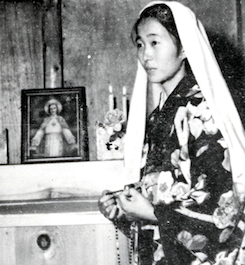Satoko Kitahara
- JOHN JANARO
Evangelization has only begun to touch the surface of Japan's ancient culture and deep religious sensibility.
 The tiny Church in Japan, however, has given a large, shining witness to their faith. Among modern Japanese converts, we have already encountered the great figure of Takashi Nagai. Satoko Kitahara is another outstanding convert from the same period. This remarkable young woman dedicated herself to the homeless people of Tokyo after World War II, helping them recover their dignity and build new communities.
The tiny Church in Japan, however, has given a large, shining witness to their faith. Among modern Japanese converts, we have already encountered the great figure of Takashi Nagai. Satoko Kitahara is another outstanding convert from the same period. This remarkable young woman dedicated herself to the homeless people of Tokyo after World War II, helping them recover their dignity and build new communities.
Satoko Kitahara was born in 1929 into a wealthy, educated family and grew up in a loving home. As a child, her religious sense was first stirred when her parents brought her to a Shinto temple and she was struck by the rituals of the Miko, female attendants dressed in white who performed certain ceremonies. She was moved to desire a pure life dedicated to the service of the highest realities. This aspiration remained with her through her adolescence and for a while was caught up in the naïve patriotism of the war. But the reality of Japan after 1945 put all of her idealism into question. Tokyo was in ruins and many were impoverished.
The disillusioned Satoko searched and wondered about the meaning of life. Around this time, she made her first visit to a Catholic church and was captivated by a statue of a woman in white (who was in fact Our Lady of Lourdes). The image remained with her, and she was stirred again when in 1949 she and her mother brought her younger sister to a Catholic school run by the Mercedarian Sisters. These were women in white habits who came from thousands of miles away to dedicate themselves to serving Jesus Christ among the Japanese people.
Satoko had found no peace or sense of purpose in her education, nor in the diversions and conventional opportunities open to an upper-class Japanese young woman. She yearned for a deeper and more pure dedication. The grace of Jesus moved her heart secretly through the witness of the sisters, and one day she decided to confide her anxieties and longings to one of the nuns, Mother Angeles Aguirre. The friendship that sprung up between them took shape as a study of the Catholic Faith, which resonated so deeply with Satoko's aspirations that in October 1949 she was baptized. The witness of Mother Angeles and the sisters had now given her a new hope: to serve Jesus as a member of their religious order.
But God had other plans for the great heart of Satoko Kitahara. The order would not accept her because of her frail health, but she was led to another kind of service among Tokyo's destitute bataya, who survived by searching through garbage to find materials that could be resold. Despised and living in squalid conditions, these people were determined to work hard, and they called their makeshift village "Ants Town." Satoko lived with them, shared their work, brought them the love of Christ, and by her luminous example led others to embrace baptism. Her inspiration, prayers, and the suffering that led to her death in 1958 from tuberculosis helped to shape the bataya of Ants Town into a model community enlivened by the presence of the Catholic Faith, whose work also pioneered recycling of reusable materials.
 This is Meaghen Gonzalez, Editor of CERC. I hope you appreciated this piece. We curate these articles especially for believers like you.
This is Meaghen Gonzalez, Editor of CERC. I hope you appreciated this piece. We curate these articles especially for believers like you.
Please show your appreciation by making a $3 donation. CERC is entirely reader supported.

Acknowledgement
 John Janaro "Satoko Kitahara." Magnificat (July, 2019).
John Janaro "Satoko Kitahara." Magnificat (July, 2019).
Reprinted with permission of Magnificat.
The Author

 John Janaro is Associate Professor Emeritus of Theology at Christendom College. He is a Catholic theologian, and a writer, researcher, and lecturer on issues in religion and culture. He is the author of Never Give Up: My Life and God's Mercy and The Created Person and the Mystery of God: The Significance of Religion in Human Life. He is married to Eileen Janaro and has five children.
John Janaro is Associate Professor Emeritus of Theology at Christendom College. He is a Catholic theologian, and a writer, researcher, and lecturer on issues in religion and culture. He is the author of Never Give Up: My Life and God's Mercy and The Created Person and the Mystery of God: The Significance of Religion in Human Life. He is married to Eileen Janaro and has five children.




